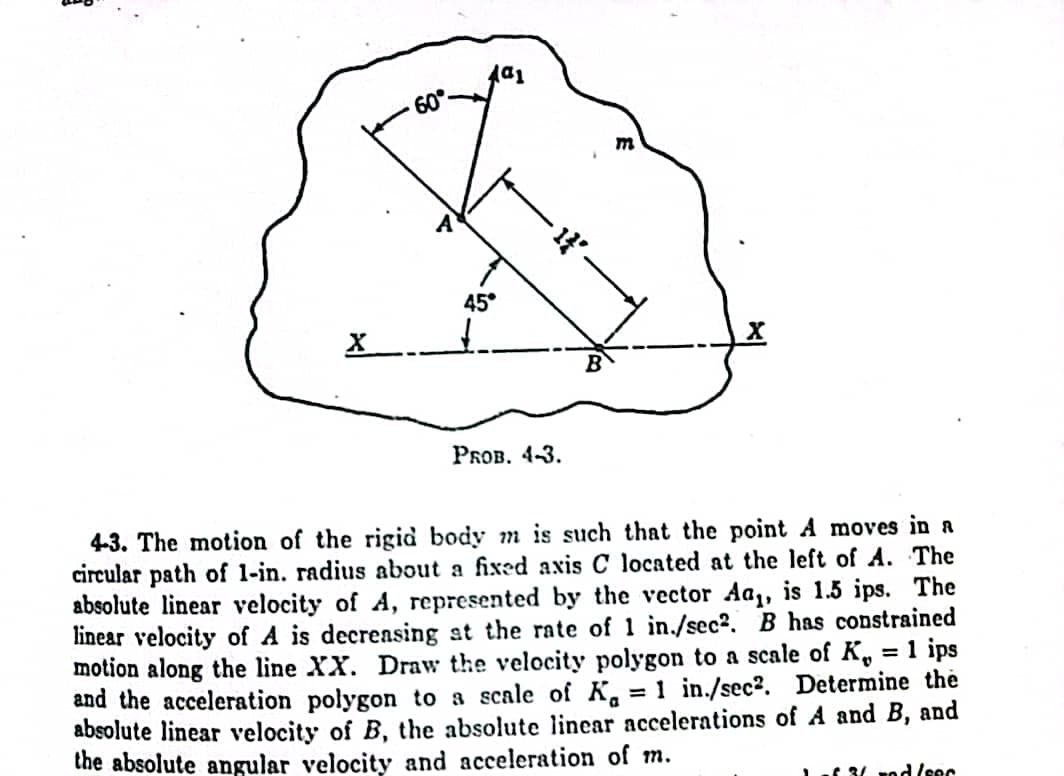4-3. The motion of the rigid body m is such that the point A moves in a circular path of 1-in. radius about a fixed axis C located at the left of A. The absolute linear velocity of A, represented by the vector Aa₁, is 1.5 ips. The linear velocity of A is decreasing at the rate of 1 in./sec2. B has constrained motion along the line XX. Draw the velocity polygon to a scale of K, = 1 ips and the acceleration polygon to a scale of K₁=1 in./sec². Determine the absolute linear velocity of B, the absolute linear accelerations of A and B, and the absolute angular velocity and acceleration of m. ad less
4-3. The motion of the rigid body m is such that the point A moves in a circular path of 1-in. radius about a fixed axis C located at the left of A. The absolute linear velocity of A, represented by the vector Aa₁, is 1.5 ips. The linear velocity of A is decreasing at the rate of 1 in./sec2. B has constrained motion along the line XX. Draw the velocity polygon to a scale of K, = 1 ips and the acceleration polygon to a scale of K₁=1 in./sec². Determine the absolute linear velocity of B, the absolute linear accelerations of A and B, and the absolute angular velocity and acceleration of m. ad less
Elements Of Electromagnetics
7th Edition
ISBN:9780190698614
Author:Sadiku, Matthew N. O.
Publisher:Sadiku, Matthew N. O.
ChapterMA: Math Assessment
Section: Chapter Questions
Problem 1.1MA
Related questions
Question
Solve graphically. Thank you

Transcribed Image Text:60°-
401
45°
PROB. 4-3.
B
m
X
4-3. The motion of the rigid body m is such that the point A moves in a
circular path of 1-in. radius about a fixed axis C located at the left of A. The
absolute linear velocity of A, represented by the vector Aa₁, is 1.5 ips. The
linear velocity of A is decreasing at the rate of 1 in./sec². B has constrained
motion along the line XX. Draw the velocity polygon to a scale of K₂ = 1 ips
= 1 in./sec2. Determine the
and the acceleration polygon to a scale of Ka
absolute linear velocity of B, the absolute linear accelerations of A and B, and
the absolute angular velocity and acceleration of m.
1 of 3 ad /sec
Expert Solution
This question has been solved!
Explore an expertly crafted, step-by-step solution for a thorough understanding of key concepts.
Step by step
Solved in 3 steps with 3 images

Knowledge Booster
Learn more about
Need a deep-dive on the concept behind this application? Look no further. Learn more about this topic, mechanical-engineering and related others by exploring similar questions and additional content below.Recommended textbooks for you

Elements Of Electromagnetics
Mechanical Engineering
ISBN:
9780190698614
Author:
Sadiku, Matthew N. O.
Publisher:
Oxford University Press

Mechanics of Materials (10th Edition)
Mechanical Engineering
ISBN:
9780134319650
Author:
Russell C. Hibbeler
Publisher:
PEARSON

Thermodynamics: An Engineering Approach
Mechanical Engineering
ISBN:
9781259822674
Author:
Yunus A. Cengel Dr., Michael A. Boles
Publisher:
McGraw-Hill Education

Elements Of Electromagnetics
Mechanical Engineering
ISBN:
9780190698614
Author:
Sadiku, Matthew N. O.
Publisher:
Oxford University Press

Mechanics of Materials (10th Edition)
Mechanical Engineering
ISBN:
9780134319650
Author:
Russell C. Hibbeler
Publisher:
PEARSON

Thermodynamics: An Engineering Approach
Mechanical Engineering
ISBN:
9781259822674
Author:
Yunus A. Cengel Dr., Michael A. Boles
Publisher:
McGraw-Hill Education

Control Systems Engineering
Mechanical Engineering
ISBN:
9781118170519
Author:
Norman S. Nise
Publisher:
WILEY

Mechanics of Materials (MindTap Course List)
Mechanical Engineering
ISBN:
9781337093347
Author:
Barry J. Goodno, James M. Gere
Publisher:
Cengage Learning

Engineering Mechanics: Statics
Mechanical Engineering
ISBN:
9781118807330
Author:
James L. Meriam, L. G. Kraige, J. N. Bolton
Publisher:
WILEY